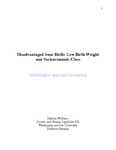Disadvantaged from Birth: Low Birth Weight and Socioeconomic Class

View/
Author
Williams, Patricia
Subject
Washington and Lee University, Shepherd Poverty Program
Birth weight, Low
Social status
Poverty
Child development
Children -- Health and hygiene
Preventive health services
Prenatal care
Health insurance
Special Supplemental Nutrition Program for Women, Infants, and Children (U.S.)
Metadata
Show full item recordDescription
Patricia Williams is a member of the Class of 2007 of Washington and Lee University. Capstone; [FULL-TEXT FREELY AVAILABLE ONLINE] This paper looks into both the causes of LBW [low birth weight] and its consequences on the physical and cognitive development of children and their resilience. It investigates how socioeconomic class can be involved in these causes and consequences by comparing factors involved in pre-natal and neonatal care including programs like WIC, access to medical care and NICUs. It focuses specifically on how these factors directly affect the infant's likelihood for survival and success both as an infant and a young child. "Babies who are very low in birth weight . . . have a 25 percent chance of dying before age one" (CTDB). The paper concludes with proposed remedies such as early intervention, prevention and holistic care for both pre-natal mothers and LBW children like that offered at PACT. [From Introduction]